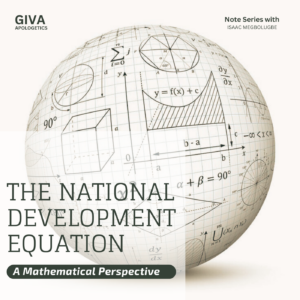The National Development Equation: A Mathematical Perspective

Isaac Megbolugbe
July 30, 2024
Introduction
National development is a complex and multifaceted concept that has puzzled policymakers and scholars for centuries. As the world grapples with the challenges of sustainable development, it is essential to explore innovative approaches to understanding and addressing these complexities. This article proposes a mathematical perspective on national development, representing it as a function with derivatives that serve as crucial parameters for informed decision-making.
The National Development Function
Let’s consider national development as a function, ND, that depends on various parameters such as:
ND = f(HC, ID, ES, GI, TA)
Where:
– HC represents Human Capital
– ID represents Infrastructure Development
– ES represents Economic Stability
– GI represents Governance and Institutions
– TA represents Technological Advancement
*The Derivative: A Measure of Progress*
The derivative of the national development function, denoted as ND’, represents the rate of change of national development with respect to a specific parameter. This measure of progress can be used to:
– Identify areas where investment yields positive returns
– Adjust policies to accelerate progress towards development goals
– Anticipate potential challenges and opportunities for growth
Applying the Derivative to National Development Planning
By analyzing the derivative, policymakers can make informed decisions about national development plans. For instance:
– A positive derivative with respect to Human Capital (HC) indicates that investments in education and training are yielding positive returns, warranting continued support.
– A negative derivative with respect to Infrastructure Development (ID) suggests that investments in infrastructure are not generating expected returns, prompting a reevaluation of strategies.
The Dangers of Focusing on a Single Derivative
Focusing solely on one derivative, like human manpower, to the exclusion of other factors can lead to:
1. _Imbalanced development_
2. _Inefficient resource allocation_
3. _Lack of sustainability_
4. _Inadequate solutions_
5. _Neglect of other critical factors_
6. _Insufficient understanding of development dynamics_
7. _Ineffective policy interventions_
8. _Unintended consequences_
Conclusion
Viewing national development as a mathematical function, with the derivative serving as a key parameter, offers a powerful tool for informed decision-making. By analyzing the rate of change of national development indicators, policymakers can optimize investments, adjust policies, and drive sustainable development. However, it is crucial to consider all relevant derivatives to avoid the pitfalls of imbalanced development, inefficient resource allocation, and unsustainable growth. By adopting a comprehensive mathematical perspective, we can navigate the complexities of national development and create a brighter future for all.